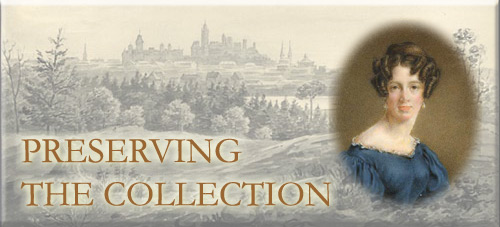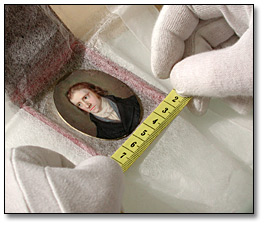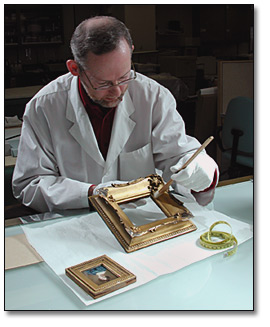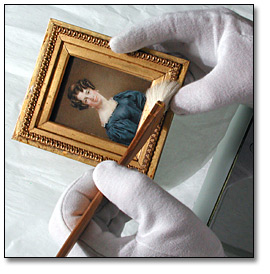
Table of Contents
Home | The Early Years | The Grand Tour | The Grand Tour- Continued
Britain - 1821-1837 | Miniatures on Ivory | Emigration - 1837
Settlement - 1837-1852 | Settlement - Continued | Peterborough and Toronto - 1852-1859
Britain & Canada: Tours and Vacations - 1860-1864 | Britain & Canada -1865-1878
Niagara, Ottawa, and Toronto - 1870s, 1880s
The Final Years | Langton Family and Family Connections | Preserving of the Collection
Resources and Acknowledgements
Preserving ivory miniatures is a unique challenge. Ivory is hygroscopic, meaning it readily takes on and retains moisture. It can also easily warp and crack when exposed to extreme temperature and humidity fluctuations. This type of support damage can lead to flaking of the image layer so environmental conditions at the Archives of Ontario are maintained at stable levels. Exposure to light is also minimized as much as possible to prevent fading of the watercolour pigments. |
 |
 |
Original frames or lockets are an integral part of these works of art so miniatures are typically preserved within these housings. Archives' conservators do not tamper with a miniature if the frame is tightly sealed. However, they do take the opportunity to replace any acidic backing boards with acid-free, high quality materials if the assembly is loose and easily opened. Preservation Services staff then house each miniature individually in custom-made enclosures. The individual packages are stored flat in acid-free boxes that are equipped with spacers to prevent them from shifting during transport. |
The miniatures are carefully handled with lint-free, cotton gloves to prevent damage from hand oils or fingerprints. Access to these unique works of art is tightly controlled to further minimize the risk of damage from handling and light exposure. As a rule, high quality digital or photographic reproductions are accessed instead of the originals. |
 |
Art Materials used by Anne LangtonGraphite: fine art lead pencils containing a crystalline allotropic form of carbon. Inks: fine art inks can be found in a variety of tones: brown, black, sepia, red, grey. Some inks are referred to as Chinese, Japan, or India ink, indicating their place of origin. Wove paper: a paper made on a wire-gauze mesh, thus yielding "a uniform unlined surface" (OED). Some of Langton's sketchbooks have "tinted" papers: grey, buff, brown and pastel tones. Watermark: high quality fine art paper sometimes bears the maker's mark - visible when the paper is held up to the light. Anne Langton sometimes sketched on such sheets. For example, she executed Rosedale in the early eighties, on paper bearing the watermark of the well-known British, paper-manufacturing firm of Whatman. Ivory: during the 18th and 19th century ivory,
from both elephant and walrus tusks, became popular for the painting
of miniature portraits due to the natural translucence of the
material which imparted a luminous quality to the image. |
|
The Early Years | The Grand Tour | The Grand Tour- Continued
Britain - 1821-1837 | Miniatures on Ivory | Emigration - 1837
Settlement - 1837-1852 | Settlement - Continued | Peterborough and Toronto - 1852-1859
Britain & Canada: Tours and Vacations - 1860-1864 | Britain & Canada -1865-1878
Niagara, Ottawa, and Toronto - 1870s, 1880s
The Final Years | Langton Family and Family Connections | Preserving of the Collection
Resources and Acknowledgements